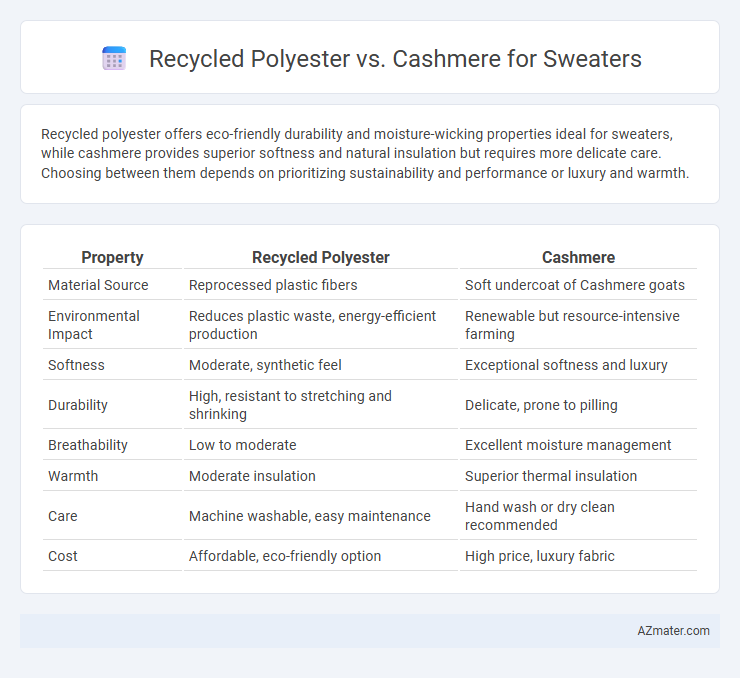Recycled polyester offers eco-friendly durability and moisture-wicking properties ideal for sweaters, while cashmere provides superior softness and natural insulation but requires more delicate care. Choosing between them depends on prioritizing sustainability and performance or luxury and warmth.
Table of Comparison
| Property | Recycled Polyester | Cashmere |
|---|---|---|
| Material Source | Reprocessed plastic fibers | Soft undercoat of Cashmere goats |
| Environmental Impact | Reduces plastic waste, energy-efficient production | Renewable but resource-intensive farming |
| Softness | Moderate, synthetic feel | Exceptional softness and luxury |
| Durability | High, resistant to stretching and shrinking | Delicate, prone to pilling |
| Breathability | Low to moderate | Excellent moisture management |
| Warmth | Moderate insulation | Superior thermal insulation |
| Care | Machine washable, easy maintenance | Hand wash or dry clean recommended |
| Cost | Affordable, eco-friendly option | High price, luxury fabric |
Overview: Recycled Polyester vs Cashmere
Recycled polyester, made from post-consumer plastic bottles, offers a sustainable, durable, and moisture-wicking alternative for sweaters, while cashmere, derived from the soft undercoat of cashmere goats, provides exceptional warmth, softness, and natural breathability. Recycled polyester is easier to care for and more affordable, making it ideal for eco-conscious consumers seeking durability, whereas cashmere delivers luxurious comfort with a premium price and requires delicate care. Both materials cater to different priorities: recycled polyester emphasizes environmental impact and practicality, while cashmere highlights luxury and natural fiber benefits.
Material Origins and Production Processes
Recycled polyester is derived from post-consumer plastic waste such as PET bottles, undergoing mechanical and chemical recycling processes to create fiber while reducing environmental impact and resource consumption. Cashmere is sourced from the fine undercoat of cashmere goats, primarily in regions like Mongolia and China, involving labor-intensive combing and hand-sorting to ensure softness and quality. The production of recycled polyester emphasizes sustainability through waste reduction and energy efficiency, whereas cashmere production relies on traditional animal husbandry and natural fiber harvesting methods.
Environmental Impact Comparison
Recycled polyester sweaters significantly reduce landfill waste and consume less water and energy compared to virgin polyester, but they still rely on fossil fuels and contribute microplastic pollution during washing. Cashmere sweaters offer natural biodegradability and carbon sequestration benefits from goat grazing, yet unsustainable herding practices can lead to overgrazing, soil degradation, and increased methane emissions. Choosing recycled polyester supports circular economy principles, while responsibly sourced cashmere prioritizes ecosystem health and biodiversity.
Durability and Longevity
Recycled polyester sweaters offer exceptional durability and resistance to wear, maintaining shape and color after multiple washes, making them ideal for long-term use. Cashmere, while luxurious and soft, tends to be more delicate and requires careful maintenance to prevent pilling and fiber breakage, resulting in a shorter lifespan without proper care. Choosing recycled polyester ensures enhanced longevity and easy care, whereas cashmere provides premium comfort but demands gentle handling to preserve its quality over time.
Comfort and Feel
Recycled polyester sweaters offer a smooth and lightweight texture with moisture-wicking properties, making them ideal for active wear and durability. Cashmere provides unmatched softness and warmth, delivering a luxurious, cozy feel that is breathable and gentle on sensitive skin. While recycled polyester excels in stretch and quick-dry performance, cashmere remains the premium choice for comfort and natural insulation in cold weather.
Warmth and Insulation
Recycled polyester offers excellent moisture-wicking properties and retains heat effectively, making it a durable, eco-friendly choice for warmth and insulation in sweaters. Cashmere provides superior thermal insulation with its fine, natural fibers that trap body heat while remaining lightweight and breathable. For optimal warmth, cashmere is favored for luxurious softness and insulation, whereas recycled polyester excels in water resistance and long-lasting heat retention.
Maintenance and Care Requirements
Recycled polyester sweaters require minimal maintenance, as they are machine washable, resist wrinkles, and dry quickly, making them ideal for everyday wear. Cashmere sweaters demand delicate care, including hand washing or dry cleaning, gentle drying, and careful storage to prevent pilling and maintain softness. Proper maintenance directly impacts the longevity of both materials, with recycled polyester offering convenience and cashmere providing luxury with higher care needs.
Price and Accessibility
Recycled polyester sweaters generally cost significantly less than cashmere, making them more accessible to a wider range of consumers seeking affordable, sustainable options. Cashmere, derived from the soft undercoat of cashmere goats, commands a premium price due to its luxurious feel, rarity, and labor-intensive production process. While recycled polyester benefits from widespread availability and machine washability, cashmere sweaters often require delicate care and are typically found in high-end retail outlets or boutique stores.
Ethical and Social Considerations
Recycled polyester sweaters reduce environmental impact by repurposing plastic waste, lowering carbon emissions, and conserving resources, making them a sustainable choice. Cashmere production often raises ethical concerns due to animal welfare issues and resource-intensive farming practices that can lead to land degradation and socioeconomic challenges for herders. Choosing recycled polyester supports circular fashion initiatives and fair labor practices, while cashmere requires careful sourcing to ensure social responsibility and ethical treatment of animals.
Choosing the Best Option for Your Sweater
Recycled polyester offers durability, moisture-wicking properties, and environmental benefits by reducing plastic waste, making it an excellent choice for eco-conscious sweater buyers. Cashmere provides unmatched softness, warmth, and luxury, ideal for those prioritizing comfort and premium quality. Choosing the best option depends on balancing sustainability and performance needs against budget and desired feel.

Infographic: Recycled polyester vs Cashmere for Sweater
 azmater.com
azmater.com